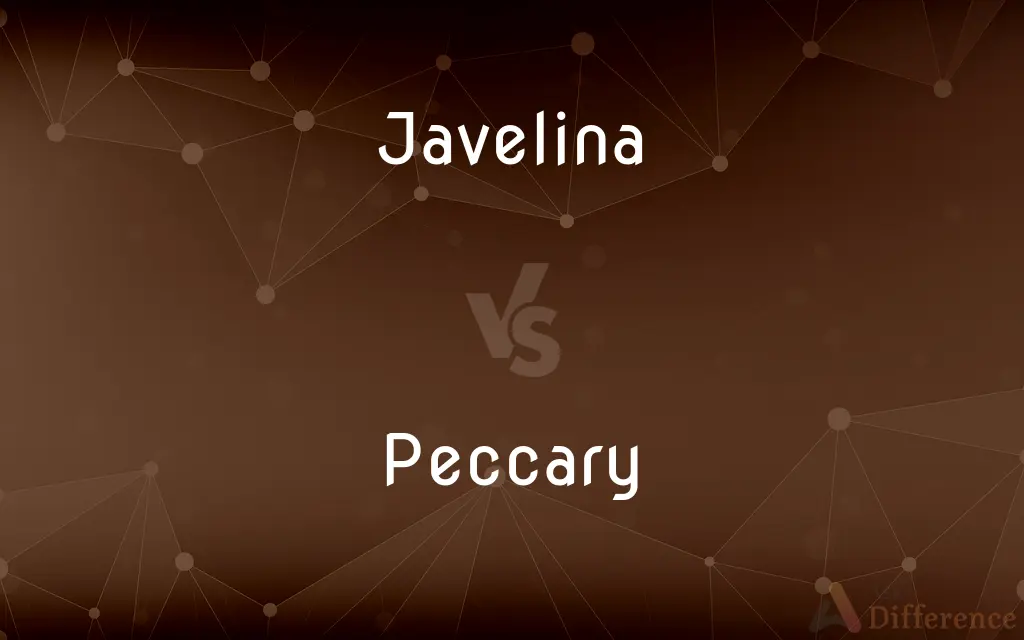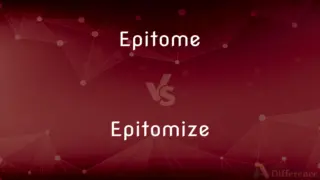Javelina vs. Peccary — What's the Difference?
By Tayyaba Rehman & Urooj Arif — Updated on May 2, 2024
Javelina refers specifically to the collared peccary, a species native to the Americas, known for its social nature; whereas, peccary is a broader term for all three species in the family Tayassuidae.

Difference Between Javelina and Peccary
Table of Contents
ADVERTISEMENT
Key Differences
Javelina is a term commonly used in the southwestern United States to describe the collared peccary, a medium-sized animal resembling a wild pig. Whereas, peccary encompasses the entire family of Tayassuidae, which includes the collared, white-lipped, and Chacoan peccary. Each species has distinct habitats and behaviors, but javelinas are particularly noted for their adaptability to arid environments.
The collared peccary, or javelina, typically forms herds of about 10 to 15 individuals to protect against predators and forage together. On the other hand, white-lipped peccaries are known to form much larger groups in the dense rainforests of Central and South America, sometimes numbering in the hundreds.
Javelinas are recognizable by their greyish-black body, short legs, and a band of white hair that looks like a collar around their shoulder. In contrast, the white-lipped peccary is darker, almost black, with a distinctive white marking on its lips and cheeks, setting them apart visually from javelinas.
Regarding behavior, javelinas are less aggressive than other peccary species. While white-lipped peccaries can be quite aggressive and are known for their sharp tusks and readiness to defend their herd, javelinas are more likely to flee when threatened
.In terms of diet, javelinas predominantly feed on cacti, mesquite beans, and small invertebrates, adapted to their desert and scrubland habitats. Peccaries, particularly the white-lipped species, have a more varied diet that includes fruits, nuts, and small animals, reflecting their more diverse tropical environments.
ADVERTISEMENT
Comparison Chart
Definition
A species within the peccary family, specifically the collared peccary.
General term for all species within the family Tayassuidae.
Habitat
Deserts and scrublands of the Americas.
Varies from rainforests to deserts across the Americas.
Group Size
Small herds (10-15 individuals).
Size varies; white-lipped can form very large herds.
Physical Characteristics
Greyish-black with a white collar of hair.
Color and size vary; generally darker with distinctive markings.
Behavior
Less aggressive, more likely to flee.
Behavior varies; some species are more aggressive.
Compare with Definitions
Javelina
Also known as the collared peccary.
The javelina, with its distinct collar of white hair, is easily identifiable.
Peccary
Social animals, some species form large herds.
The herd of peccaries moved through the forest floor.
Javelina
A wild hoofed mammal of the peccary family, native to the Americas, especially the southwestern U.S.
We saw a herd of javelinas foraging near the campsite.
Peccary
Includes species such as the white-lipped peccary and Chacoan peccary.
The white-lipped peccary is known for its aggressive behavior.
Javelina
Not true pigs but often mistaken for them due to their appearance.
Despite appearances, javelinas are not related to domestic pigs.
Peccary
Any of the three species of medium-sized mammals belonging to the family Tayassuidae.
Peccaries are found throughout Central and South America.
Javelina
Known for its gregarious nature, forming small groups.
Javelinas stick together to protect themselves from predators.
Peccary
Adapted to a variety of habitats, from rainforests to deserts.
Peccaries adapt their diet based on their environment.
Javelina
Primarily feeds on cacti and desert vegetation.
The javelina was munching on a piece of prickly pear.
Peccary
Distinguished by strong social structures and complex behaviors.
Peccaries communicate with various sounds and scents.
Javelina
See collared peccary.
Peccary
A peccary (also javelina or skunk pig) is a medium-sized pig-like hoofed mammal of the family Tayassuidae (New World pigs). They are found throughout Central and South America and in the southwestern area of North America.
Javelina
(North America) The peccary, especially the collared peccary.
Peccary
Any of several piglike hoofed mammals of the family Tayassuidae, found in North, Central, and South America and having stiff bristles and short, straight tusks.
Javelina
Dark gray peccary with an indistinct white collar; of semi desert areas of Mexico and southwestern United States
Peccary
Any of the family Tayassuidae of mammals from the Americas, related to pigs and hippos.
Peccary
A pachyderm of the genus Dicotyles.
Peccary
Nocturnal gregarious pig-like wild animals of North America and South America
Common Curiosities
What is a javelina?
A javelina is a species of peccary known as the collared peccary, commonly found in the southwestern U.S. and throughout Central and South America.
What kind of habitat do javelinas prefer?
Javelinas are adapted to arid environments such as deserts and scrublands, where they forage for cacti, mesquite beans, and other vegetation.
Can peccaries be found outside the Americas?
No, peccaries are native to the Americas only, ranging from the southwestern United States down through Central and South America.
Are javelinas dangerous to humans?
Javelinas are generally not dangerous unless provoked or cornered. They are more likely to flee from humans but can defend themselves vigorously if threatened.
How does a peccary differ from a javelina?
A peccary refers to any member of the three species within the family Tayassuidae, including javelinas (collared peccaries), white-lipped peccaries, and Chacoan peccaries. Javelina specifically refers to the collared peccary.
What conservation measures are in place for peccaries?
Conservation efforts for peccaries include habitat preservation, anti-poaching laws, and wildlife corridors that allow for their migration and genetic diversity.
What are the main threats to peccaries in the wild?
The main threats include habitat loss due to deforestation and agriculture, hunting for meat and sport, and competition with livestock.
What do peccaries eat?
Peccaries are omnivorous and their diet can include fruits, nuts, small animals, and vegetation, varying significantly depending on species and habitat.
Are peccaries considered keystone species in their ecosystems?
Yes, in many of their habitats, peccaries are considered keystone species because they help maintain the ecological balance by dispersing seeds and controlling plant growth.
How do javelinas communicate with each other?
Javelinas communicate through various vocalizations, body language, and scent marking to maintain social bonds and warn of predators.
How long do javelinas live?
In the wild, javelinas can live up to 10 years, though their lifespan may be shorter due to predation and environmental factors.
Share Your Discovery

Previous Comparison
Abate vs. Mitigate
Next Comparison
Epitome vs. EpitomizeAuthor Spotlight
Written by
Tayyaba RehmanTayyaba Rehman is a distinguished writer, currently serving as a primary contributor to askdifference.com. As a researcher in semantics and etymology, Tayyaba's passion for the complexity of languages and their distinctions has found a perfect home on the platform. Tayyaba delves into the intricacies of language, distinguishing between commonly confused words and phrases, thereby providing clarity for readers worldwide.
Co-written by
Urooj ArifUrooj is a skilled content writer at Ask Difference, known for her exceptional ability to simplify complex topics into engaging and informative content. With a passion for research and a flair for clear, concise writing, she consistently delivers articles that resonate with our diverse audience.
















































